RISCO Group Wireless WatchOUT PIR Outdoor User Manual [en, it, es, fr]
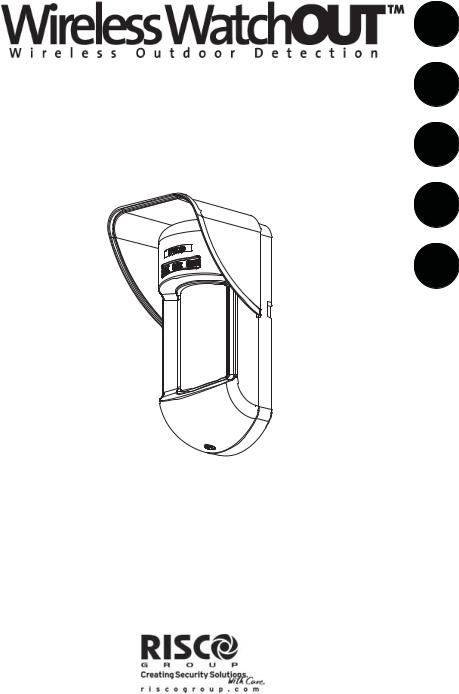
Wireless PIR Outdoor Detector Rivelatore PIR da esterno via radio Detector Inalámbrico de Exterior PIR Détecteur PIR extérieur sans fil
Detector Infravermelho Passivo Externo Sem Fio
WL T312
Installation Instructions
Istruzioni per l’installazione
Instrucciones de Instalación
Manuel d'installation
Instruções para Instalação

2 |
Installation Instructions |

Table of Contents |
EN |
Installation ................................................................................................................. |
4 |
Introduction................................................................................................................ |
4 |
Mounting .................................................................................................................... |
4 |
Mounting Considerations ........................................................................................................... |
4 |
Wall Mount Installation ............................................................................................................... |
6 |
Flat Mounting:............................................................................................................................. |
6 |
45° angle Mounting (Left side mounting) .................................................................................. |
6 |
Changing Back Tamper position ............................................................................................... |
7 |
Back Tamper Terminal Wiring ..................................................................................... |
7 |
DIP Switch Settings .................................................................................................... |
7 |
Walk test ..................................................................................................................................... |
8 |
LEDs Display .............................................................................................................. |
8 |
Operational Modes:..................................................................................................... |
8 |
Transmitter/Receiver Communication link setup: ......................................................... |
8 |
High / Low power Jumper............................................................................................ |
9 |
Standard Swivel Installation ........................................................................................ |
9 |
Wall Mounting............................................................................................................................. |
9 |
Replacing Lenses ..................................................................................................... |
11 |
Lens Types............................................................................................................... |
12 |
Technical Specification ............................................................................................. |
13 |
Ordering Information ................................................................................................ |
13 |
Accessories Kits....................................................................................................... |
13 |
Installation Instructions |
3 |
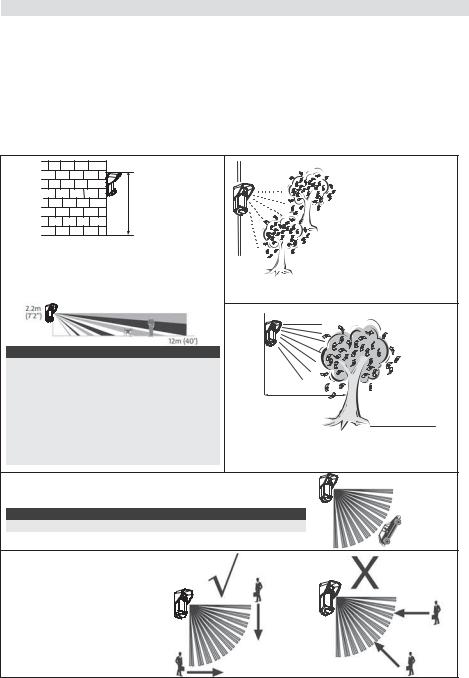
1. For low installations, below 1.7m (5'6") in which |
|
|
|
pet immunity is required, use the supplied |
|
|
|
RL300F lens (Low wall or fence installations). |
5m (16') |
Out of |
|
2. The detector's pet immunity (height of an animal, |
Detection Range |
||
|
|||
no weight limitation), is up to 70 cm (2'4"), when |
With moving objects |
|
|
installing the detector at 2.2m (7'2"). If the |
keep distance of |
|
|
installation is below the height mentioned above, |
minimum 5 meters (16') |
|
|
the Pet Immunity decreases accordingly; every |
Ensure any objects do not obstruct the field of |
||
10 cm (4") decrease in installation height leads |
view. Pay attention to growing trees or bushes, |
||
to 10 cm (4") decrease in pet height immunity. |
|||
plants with big moving leaves etc. |
|||
|
|||
For installations with extensive vehicle traffic or targets beyond |
|
||
the required detection range, it is recommended to tilt the |
|
||
detector down. |
|
|
|
Note: |
|
|
|
Tilting the detector down may reduce the pet immunity |
|
|
|
For optimum detection, select a location that is likely to intercept an intruder moving across the coverage pattern at a 45° trajectory.
4 |
Installation Instructions |
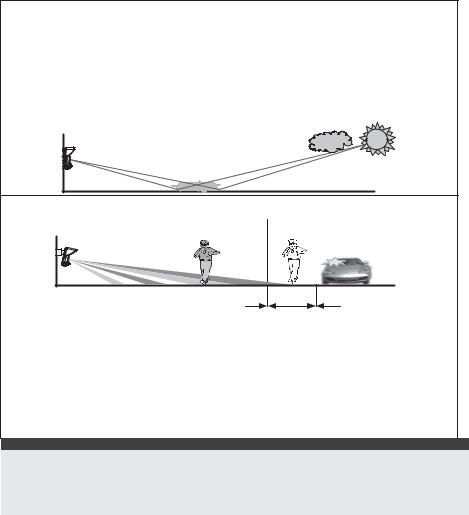
Installing Wireless WatchOUT PIR in challenging situations:
In the following situations, rapid and significant infrared radiation changes can happen in both PIR channels together, resulting in false alarms and therefore care should be taken.
1.Situations in which metal and/or glass objects measuring over 70cm (2’4”) in height from the ground are in the field of view of the detector (cars, metal gates, shutters, metal walls, windows, etc.)
2.Situations in which a reflective surface on the ground larger than 1m (3’4”) in diameter may cause reflection into the detector’s lens. Examples of a reflective surface on the ground are a puddle, wet road or car park, smooth concrete or asphalt surface, swimming pool, etc.
Water Reflection |
To avoid false alarms in the above situations:
Area 1 |
|
Area 2 |
|
1m |
12m |
|
(40') |
|
|
|
Reduce the detection range to 1m less than the distance of the metal/glass object or possible ground surface reflection, as follows:
1.Install the Wireless WatchOUT PIR on the supplied standard swivel bracket.
2.Reduce the detection range by sliding up the Wireless WatchOUT PCB within the detector housing, and by tilting the detector down on the swivel bracket.
3.To reduce the required tilting angle, it is recommended to install the detector at a lower mounting height and to use the Pet immune lens for low installations.
4.Confirm by walk-test that the Wireless WatchOUT PIR detects in Area 1, and that no detection occurs when walking in Area 2.
NOTES:
1.Please note that any outdoor PIR detector will require reduction in range to a shorter distance than the car, metal object or surface reflection (so that these objects won’t be protected) in order to eliminate false alarms.
2.For full 15m (50’) coverage in the above situations, it is highly recommended to install the wired WatchOUT DT, the only outdoor detector with 2 PIR channels and 2 Microwave channels.
3.Wireless WatchOUT detectors include high quality Silicon filters on the PIR sensors for blocking out white light interferences. These filters are not intended to block infrared thermal radiation.
Installation Instructions |
5 |
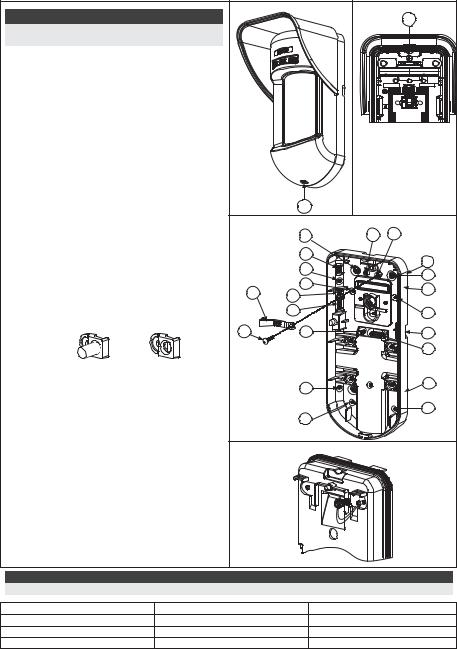
Wall Mount Installation |
|
|
|
|
|
|
Note: |
|
Figure 1 |
|
Figure 2 |
||
|
|
|
|
I1 |
||
The installation knockouts numbering are marked |
|
|
|
|
||
on the back plate. |
|
|
|
|
|
|
1. Open Wireless WatchOUT front cover |
|
|
|
|
||
|
(unlock C1, Figure 1). |
|
|
|
|
|
2. Release internal base (unlock I1, Figure |
|
|
|
|
||
|
2). |
|
|
|
|
|
3. Select mounting installation as follows: |
|
|
|
|
||
Flat Mounting: |
|
|
|
|
|
|
Open knockouts on external base (Figure 3). |
|
|
|
|
||
|
x B1 - B4: Wall mounting knockouts |
|
|
|
|
|
|
x T1: Back tamper knockout |
|
|
|
|
|
45° angle Mounting (Left side |
|
|
|
|
||
mounting): |
|
|
C1 |
|
|
|
|
a. Open knockouts on external base |
Figure 3 |
|
|
|
|
|
(Figure 3). |
|
|
T1 |
T6 |
T5 |
|
x L1, L2: Left mounting knockouts |
|
|
|
|
|
|
x T3: Left tamper knockout |
|
T3 |
|
T4 |
|
|
b. Remove tamper spring (Figure 4). |
Tamper |
L1 |
|
||
|
|
T2 |
||||
|
|
|
||||
|
c. Replace tamper bracket (Item 1) with |
Lever |
B1 |
|
R1 |
|
|
B |
W5 |
|
|||
|
supplied flat tamper bracket (Item 2). |
|
(not visible) |
|||
|
|
|
||||
|
|
W6 |
|
|||
|
|
|
|
|
B2 |
|
|
Item 1 |
Item 2 |
|
|
|
|
|
A |
W3 |
|
W9 |
||
|
|
|
|
|||
|
|
|
|
|
|
W2 |
d. Insert Tamper lever B onto T6 and T3 |
|
|
|
R2 |
||
|
and secure screw A (Figure 3). |
|
L2 |
|
||
|
|
|
(not visible) |
|||
4. |
Secure external base to the wall. |
|
|
|
||
|
|
|
B3 |
|||
5. |
Insert tamper wires through internal base |
|
B4 |
|
|
|
|
(Figure 4). |
|
|
|
|
|
6. |
Secure internal base to external base (lock |
Figure 4 |
|
|
|
|
|
I1, Figure 2). |
|
|
|
|
|
7. Close the front cover (Lock C1, Figure 1) |
|
|
|
|
||
|
after wiring and setting DIP switches. |
|
|
|
|
|
8. |
Walktest the detector. |
|
|
|
|
|
Note:
For 45° right side installation use the equivalent units on the external base as follows:
Knockouts Description |
Left |
Right |
Mounting Knockouts |
L1, L2 |
R1, R2 |
Tamper spring knockouts |
T1,T3 |
T2,T4 |
Tamper screw anchor |
T5 |
T6 |
6 |
Installation Instructions |

Changing Back Tamper position
The back tamper is by default secured on the right side of the internal base (Rear view). If you wish to move it to the left side (rear view), do the following (Figure 5):
1.Remove tamper screw 1 in order to release the tamper from position 7.
2.Ensure tamper spring (2) rests over tamper wire base 4.
3.Ensure plastic tamper bracket (3) rests over both 2 and 4.
4.Secure tamper screw (1) into (3) over position 6.
Notes:
Figure 5
Left Side
Tamper
6
Right Side
Tamper
3 |
7 |
1

 5 4
5 4
2
1.Verify that you hear a "Click" when attaching the tamper spring to the wall.
2.For pole installation, the tamper can be moved to the bottom right-hand side of the internal base.
Back Tamper Terminal Wiring
If you wish to use the back tamper (recommended) remove the short from the back tamper terminal block and connect the back tamper wires to the back tamper terminal block.
BACK TAMPER
Back Tamper in use |
Back Tamper not used |
H1 |
H1 |
|
Short |
DIP Switch Settings
ON |
|
|
|
|
|
|
|
|
|
|
Factory |
|
|
|
|
|
|
|
|
|
|
|
|
|
|
|
|
|
|
|
|
|
|
|
|
|
|
Default |
|
|
|
|
|
|
|
|
|
|
|
|
|
|
1 |
2 |
3 |
4 |
5 |
6 |
|
|||||
DIP 1: LEDs operation On: LEDs enabled Off: LEDs disabled
DIP 2-3: PIR Detection Sensitivity
Sensitivity |
DIP2 |
DIP3 |
Low |
Off |
Off |
Mid |
Off |
On |
Normal |
On |
Off |
Maximum |
On |
On |
DIP 4: Supervision time On: 65 minutes Off: 15 minutes
DIP 5: Normal/Test modes On: Test
Off: Normal
DIP 6: Anti masking operation On: Enabled
Off: Disabled
Installation Instructions |
7 |

Walk test
Two minutes after applying power, walk test the protected area to verify |
|
|
proper operation. |
|
1.00M |
For installations on uneven surfaces slide the PCB inside the internal base to |
|
1.50M |
the appropriate setting according to the desired height (1.0m, 1.5m, 2.2m, |
|
2.20M |
2.7m) as printed on the bottom left corner of the PCB or use the standard |
|
2.70M |
|
swivel accessory. |
PCB |
For reducing the detection range, slide the PCB up or tilt the swivel down. |
LEDs Display
LED |
State |
Description |
RED |
Steady |
Indicates ALARM |
RED & YELLOW |
RED followed By |
Indicates ALARM + Anti-masking |
|
YELLOW |
|
Operational Modes:
Operational Mode |
Description |
Normal |
Dead time (between detection alarms) is 2.5 Minutes. |
Test (walk test) |
Dead time (between detection alarms) is 2.5 sec. |
Write |
The unit transmits a WRITE message each time both of the Tamper |
|
Switches (back and cover) are closed for at least 3 seconds. |
Notes:
After power up the detector enters into test mode for a period of 20 minutes (disregarding the DIP switch Modes Position).
Transmitter/Receiver Communication link setup
The detector must identify itself to the system’s receiver by writing its coded message into the receiver’s address memory. This is accomplished by performing the following steps:
1.Set the receiver to Write Mode.
2.Remove the insulation material from the batteries and place them in the batteris holders on the PCB on the right direction (pay attention to the "+" and "–" diagram on the PCB)
3.Send a WRITE message by pressing both of the tamper switches (back and cover) for at least 3 seconds.
4.Verify that the detector has been identified by the receiver.
CAUTION NOTICE
Changes or modifications not expressly approved by RISCO Group may void the user’s authority to operate this equipment.
Simultaneous transmissions from two different units may cause message interference resulting in loss of information.
The communication quality of this unit may be affected by its surrounding environment. Nearby electrical equipment may interfere with its normal operation.
The operation of this unit must, therefore, be tested at each installation since its transmission quality may vary as a result of operational conditions.
NOTE:
DIP-Switch 1 should be in ON position to enable LED indications (regardless during the first 20 minutes after power up).
8 |
Installation Instructions |

High / Low power Jumper |
Low |
High |
Power |
power |
The jumper on selector J8 needs to be on OFF (High Power position) unless sold in countries with FCC compliance.
Standard Swivel Installation
The Outdoor detector packaging contains a standard swivel for flexible installation. Please follow the instructions below for mounting the detector with the Standard Swivel:
1.Open Wireless WatchOUT front cover (Unlock C1, Figure 1).
2.Release internal base (Unlock I1, Figure 2).
3.Remove back tamper from the internal base (see the “Changing Back Tamper Position" paragraph on page 7) and connect it to S5 (Figure 6, Detail A) on the Standard Swivel.
4.Select the mounting installation as follows:
Note:
Ensure that you see the engraved UP mark on the upper front face of the swivel.
Wall Mounting:
1.Insert back tamper wires through the Swivel Wires Passage (Figure 6, Detail B).
2.Secure swivel to the wall through holes S1, S3, S6 and S8.
|
Detail A |
Detail B |
Standard Swivel |
|
|
S1 |
S2 |
Snaps |
|
|
|
|
|
W1 |
|
S4 |
S1 |
S2 |
S8 |
|
||
|
|
||
|
|
S3 |
|
|
|
|
S5 |
Detail C |
|
S6 Tamper
(see Detail C)
Figure 6
3.Connect the external base to the swivel using the dedicated snaps (Figure 8).
Installation Instructions |
9 |
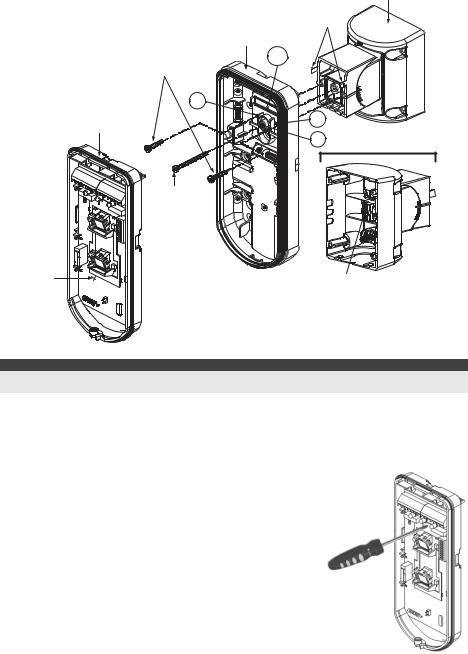
See Detail A
Snaps
External Base
Swivel to External Base |
W1 |
|
|
Connecting Screws |
|
S1 |
|
S2
Internal Base
S3
Detail A
Angle Locking
Screw
(See Note 2)
PCB |
Swivel Assy |
|
Connecting Screw |
|
(See Note) |
Figure 7
NOTE:
Do not open or close the Swivel Assy Screw since it is used for connecting the swivel parts only (factory tightened).
4.Secure external base to swivel with two screws fastened trough knockouts S1 and S2 (Figure 7).
5.Insert the supplied angle locking screw from the external base through the angle locking screw knockout S3 on the external base to the standard swivel (Figure 7).
6.Tilt and Rotate the Standard Swivel to the desired position. Once the Standard Swivel is in the desired position, secure the angle locking screw.
7.Line up the internal base onto the external base. Insert tamper wiring through the internal base.
8.Secure internal base to external base (Lock I1, Figure 2).
9.To readjust the Standard Swivel when the PCB is installed (Figure 8):
a.Bend down the black foam located below the RED LED on the PCB (enough to reach the Swivel locking screw).
b.Use a Hex screwdriver to release the locking screw (see Figure 8).
c.Tilt and/or Rotate the Standard Swivel to the desired position.
d.Secure the angle locking screw.
Figure 8: PCB
10 |
Installation Instructions |
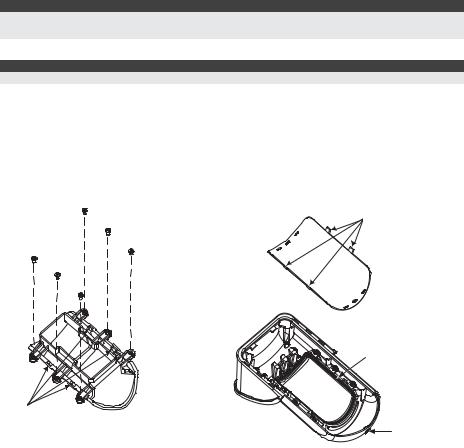
NOTE:
When marks on the two movable parts are aligned (Figure 7), the Standard Swivel is in 0q vertical /horizontal position. Each click from this position represents shifting of 5q in vertical / horizontal position.
10. Close the front cover (Lock C1, Figure 1) and walk test the detector.
NOTE:
The screw has to pass through External Base and locked to the swivel.
Replacing Lenses
1.Unlock the six screws that hold the lens holding sleeve from the back of the front cover.
2.To release the protective sleeve, gently push the lens from the external side of the front cover.
3.Disconnect the lens from the sleeve by gently pushing the lens clips that secure it to the sleeve.
4.Replace the lens. Place the 4 clips of the lens into the matching holes on the sleeve.
5.Insert the protective sleeve back into place on the front cover. Pay attention to place the sleeve over the sealing rubber.
6.Secure the 6 holding screws back to their place.
Lens Locking
Clips
Sleeve Locking
 Screws
Screws
Sealing Rubber
Lens Protecting
Sleeve
Sockets for
Lens Clips
.
Figure 9
Front Cover
Locking Screw
Installation Instructions |
11 |
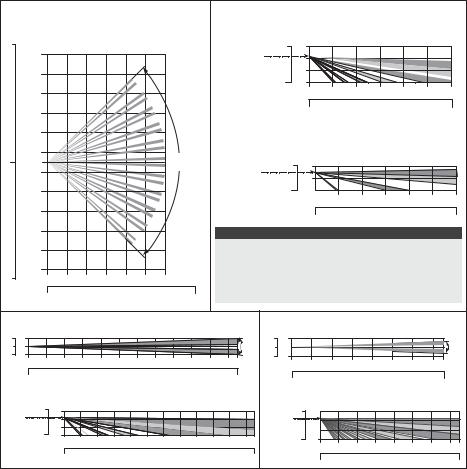
Lens Types |
|
|
|
|
|
|
|
|
|
|
|
|
|
|
|
|
|
||
|
Wide angle lens (RL300) / |
|
|
|
Wide angle lens (RL300): |
|
|
|
|||||||||||
|
Low installation Pet lens (RL300F) : |
|
|
|
Side View |
|
|
|
|
||||||||||
40 |
|
|
Top view |
|
|
|
|
Typical |
Feet |
|
|
|
|
|
|
|
|||
|
|
|
|
|
|
|
|
|
10 |
3 |
|
|
|
|
|
|
|
||
11 |
|
|
|
|
|
|
|
|
Installation |
|
|
|
|
|
|
|
|||
|
|
|
|
|
|
|
|
|
|
|
|
|
|
|
|
|
|
||
|
|
|
|
|
|
|
|
|
Height: |
|
|
|
|
|
|
|
|
|
|
|
|
|
|
|
|
|
|
|
|
|
|
|
|
|
|
|
|
|
|
30 |
9 |
|
|
|
|
|
|
|
|
2.2m (7'2") |
|
1 |
|
|
|
|
|
|
|
|
|
|
|
|
|
|
|
|
|
|
0 |
0 |
|
|
|
|
|
|
|
|
7 |
|
|
|
|
|
|
|
|
|
Meters 0 |
|
2 |
4 |
6 |
8 |
10 |
12 |
|
|
|
|
|
|
|
|
|
|
|
Feet |
|
|
|
|
|
|
|
||
20 |
|
|
|
|
|
|
|
|
|
|
|
|
|
|
|
|
|
||
|
5 |
|
|
|
|
|
|
|
|
|
|
0 |
|
10 |
|
20 |
|
30 |
40 |
10 |
3 |
|
|
|
|
|
|
|
|
Low installation - Pet lens (RL300F) : |
|
||||||||
|
|
|
|
|
|
|
|
|
|
|
Side view |
|
|
|
|
||||
|
|
|
|
|
|
|
|
|
|
|
|
|
|
|
|
|
|||
|
1 |
|
|
|
|
|
|
90° |
|
Typical |
Feet |
|
|
|
|
|
|
|
|
0 |
0 |
|
|
|
|
|
|
|
|
|
|
|
|
|
|
||||
|
|
|
|
|
|
|
Installation |
6 |
2 |
|
|
|
|
|
|
|
|||
|
1 |
|
|
|
|
|
|
|
|
|
|
|
|
|
|
|
|||
|
|
|
|
|
|
|
|
|
Height: |
|
1 |
|
|
|
|
|
|
|
|
|
|
|
|
|
|
|
|
|
|
|
|
|
|
|
|
|
|
||
|
|
|
|
|
|
|
|
|
|
1.5m (5'3") |
|
|
|
|
|
|
|
|
|
10 |
3 |
|
|
|
|
|
|
|
|
0 |
0 |
|
|
|
|
|
|
|
|
|
|
|
|
|
|
|
|
|
|
|
|
|
|
|
|
||||
|
|
|
|
|
|
|
|
|
|
|
Meters |
0 |
2 |
4 |
6 |
8 |
10 |
12 |
|
|
5 |
|
|
|
|
|
|
|
|
|
|
Feet |
|
|
|
|
|
|
|
20 |
|
|
|
|
|
|
|
|
|
Note: |
|
|
0 |
10 |
|
20 |
|
30 |
40 |
|
7 |
|
|
|
|
|
|
|
|
|
|
|
|
|
|
|
|
|
|
|
|
|
|
|
|
|
|
|
|
|
|
|
|
|
|
|
|
|
|
30 |
9 |
|
|
|
|
|
|
|
|
The detector's Pet Immunity (height of an animal, no weight |
|||||||||
|
|
|
|
|
|
|
|
limitation), is up to 70 cm (2'4"), when installing the |
|
||||||||||
|
|
|
|
|
|
|
|
|
|
|
|||||||||
|
11 |
|
|
|
|
|
|
|
|
detector at 2.2m (7'2"). If the installation is bellow the |
|
||||||||
40 |
0 |
2 |
4 |
6 |
8 |
10 |
12 |
14 |
15 |
height mentioned above, the Pet Immunity decreases |
|
||||||||
|
|
|
|
|
|
|
|
|
|
accordingly; every 10 cm (4") decrease in installation |
|
||||||||
|
0 |
10 |
|
20 |
|
30 |
40 |
|
50 |
height leads to 10 cm (4") decrease in pet height immunity. |
|||||||||
|
|
Long range lens (RL300LR): Top view |
|
|
|
Barrier lens (RL300B): Top view |
|
||||||||||||||||||||
Feet |
|
|
|
|
|
|
|
|
|
|
|
|
|
|
Feet |
|
|
|
|
|
|
|
|
|
|
||
3 |
1 |
|
|
|
|
|
|
|
|
|
|
|
|
|
|
3 |
1 |
|
|
|
|
|
|
|
|
|
|
0 |
0 |
|
|
|
|
|
|
|
|
|
|
|
|
|
5° |
0 |
0 |
|
|
|
|
|
|
|
|
5° |
|
3 |
1 |
2 |
4 |
6 |
|
8 |
10 |
12 |
|
14 |
16 |
18 |
20 |
22 23 |
3 |
1 |
|
|
|
|
|
|
|
|
|
|
|
Meters 0 |
|
|
Meters |
0 |
2 |
4 |
6 |
8 |
10 |
12 |
14 |
15 |
|
||||||||||||||
|
Feet |
|
|
|
|
|
|
|
|
|
|
|
|
|
|
|
|||||||||||
|
|
|
|
|
|
|
|
|
|
|
|
|
|
|
|
Feet |
|
|
|
|
|
|
|
|
|
|
|
|
0 |
|
10 |
20 |
|
30 |
|
40 |
|
50 |
|
60 |
70 |
|
75 |
|
|
|
|
|
|
|
|
|
|
|
|
|
|
|
|
|
|
|
|
0 |
10 |
|
20 |
30 |
|
40 |
|
50 |
|
||||||||||
|
|
|
|
|
|
|
|
|
|
|
|
|
|
|
|
|
|
|
|
|
|||||||
|
|
Long range lens (RL300LR): Side view |
|
|
Barrier lens (RL300B): Side view |
|
|||||||||||||||||||||
Typical |
10 |
3 |
|
|
|
|
|
|
|
|
|
|
|
|
|
|
Feet |
|
|
|
|
|
|
|
|
||
Installation |
|
|
|
|
|
|
|
|
|
|
|
|
Typical |
10 |
3 |
|
|
|
|
|
|
|
|
||||
Height: |
|
|
|
|
|
|
|
|
|
|
|
|
|
|
|
|
|
|
|
|
|
|
|
|
|||
|
|
|
|
|
|
|
|
|
|
|
|
|
|
Installation |
|
|
|
|
|
|
|
|
|
|
|||
2.2m (7'2") |
|
1 |
|
|
|
|
|
|
|
|
|
|
|
|
|
|
|
|
|
|
|
|
|
|
|||
|
|
|
|
|
|
|
|
|
|
|
|
|
Height: |
|
1 |
|
|
|
|
|
|
|
|
||||
|
|
0 |
|
|
|
|
|
|
|
|
|
|
|
|
|
|
|
|
|
|
|
|
|
||||
|
|
0 |
|
|
|
|
|
|
|
|
|
|
|
|
2.2m (7'2") |
|
|
|
|
|
|
|
|
|
|||
|
|
|
|
|
|
|
|
|
|
|
|
|
|
0 |
0 |
|
|
|
|
|
|
|
|
||||
|
|
Meters 0 |
2 |
4 |
6 |
|
8 |
10 |
12 |
14 |
16 |
18 |
20 |
22 23 |
|
|
|
|
|
|
|
|
|
||||
|
|
|
|
Meters 0 |
2 |
4 |
6 |
8 |
10 |
12 |
14 |
15 |
|||||||||||||||
|
|
|
Feet |
|
|
|
|
|
|
|
|
|
|
|
|
|
|
||||||||||
|
|
|
|
|
|
|
|
|
|
|
|
|
|
|
|
|
|
Feet |
|
|
|
|
|
|
|
|
|
|
|
|
0 |
10 |
|
20 |
|
30 |
|
40 |
|
50 |
60 |
|
70 |
75 |
|
|
|
|
|
|
|
|
|
|
|
|
|
|
|
|
|
|
|
|
|
0 |
|
10 |
20 |
|
30 |
40 |
|
50 |
|||||||||
|
|
|
|
|
|
|
|
|
|
|
|
|
|
|
|
|
|
|
|
|
|
||||||
12 |
Installation Instructions |

Technical Specification
Electrical
Current consumption (standby) |
35uA at 3 VDC (average) |
Current consumption (Alarm |
43mA at 3 VDC (Max. with LED OFF) |
transmission) |
53mA at 3 VDC (Max. with LED ON) |
Dead time (Normal Mode) |
2.5 minutes |
Modulation type |
ASK |
Battery life |
3 years (Normal Mode) |
Supervision transmission |
Every 15/65 minutes. |
Address codes |
16 Millions |
Range (loss) |
300m (1000 feet) |
Voltage requirements |
CR123A 2 X 3VDC Lithium Batteries |
Frequency |
433.995 / 868.65MHz |
Physical |
|
|
|
Size (LxWxD) |
230 x 121 x 123mm (9 x 4.76 x 4.85 in.) |
Environmental |
|
|
|
Operating/Storage temperature |
-25°C to 60°C (-13°F to 140°F) |
* PIR technology is limited in rough environmental conditions. |
|
RF immunity |
According to EN50130-4 |
* Specifications are subject to change without prior notice.
Ordering Information
Model |
Description |
WL T312 |
WatchOUT Wireless PIR 868/433 + swivel |
Note: The detector contains a standard swivel and 3 replacement lenses
(P/N engraved on the Lens): 1.7m low installation pet (RL300F), Long-range (RL300R), Barrier lens (RL300B).
Accessories Kits
Model |
Description |
Weight |
RA300B |
Barrier Swivel Kit |
0.1 Kg (0.23 lb) |
RA300P |
WatchOUT Pole Adaptor Kit |
0.25 Kg (0.55 lb) |
RA300HS |
WatchOUT Demo Housing |
NA |
Installation Instructions |
13 |
14 |
Installation Instructions |

Indice dei contenuti |
IT |
Installazione............................................................................................................ |
16 |
Introduzione........................................................................................................... |
16 |
Installazione........................................................................................................... |
16 |
Considerazioni preliminari ................................................................................... |
16 |
Installazione a parete .......................................................................................... |
18 |
Installazione piana:.............................................................................................. |
18 |
Installazione angolare di 45° (installazione a sinistra) ......................................... |
18 |
Descrizione fori a sfondare.................................................................................. |
18 |
Modifica della posizione del tamper antirimozione .............................................. |
19 |
Cablaggio del tamper antirimozione.................................................................... |
19 |
Predisposizione Microinterruttori ........................................................................ |
19 |
Prova di movimento.............................................................................................. |
20 |
Indicatori LED ........................................................................................................ |
20 |
Modi operativi:....................................................................................................... |
20 |
Autoapprendimento del trasmettitore ................................................................. |
20 |
Ponticello Alta / Bassa potenza ........................................................................... |
21 |
Installazione dello snodo standard...................................................................... |
21 |
Installazione a parete ........................................................................................... |
21 |
Sostituzione delle Lenti ........................................................................................ |
23 |
Tipologie di Lenti................................................................................................... |
24 |
Specifiche tecniche............................................................................................... |
25 |
Informazioni per l’ordine........................................................................................ |
25 |
Kit accessori ........................................................................................................... |
25 |
Istruzioni per l’installazione |
15 |

5m (16')
Mantenere una distanza di almeno 5m (16') da oggetti in movimento
Fuori campo di rilevazione
Assicurarsi che nessun oggetto ostruisca il campo di rilevazione dell’unità. Prestare attenzione alla crescita di alberi, rami e ad eventuali altre piante che con il tempo possono coprire l’area di rilevazione.
Per quelle installazioni vicino a strade ad intenso traffico di veicoli o altri oggetti in movimento oltre l’area di rilevazione desiderata, si consiglia di inclinare il rivelatore verso il basso fino ad evitare la copertura dell’area di passaggio degli autoveicoli.
Note:
Inclinando il rivelatore verso il basso è possibile che la funzione di immunità agli animali venga ridotta.
16 |
Istruzioni per l’installazione |

Per una migliore rivelazione selezionare una posizione di installazione in modo che l’eventuale intruso attraversi l’area di copertura perpendicolarmente rispetto alla posizione del rivelatore.
Installazione del WatchOUT PIR Radio in situazioni critiche:
Nelle seguenti situazioni variazioni delle radiazioni all’infrarosso rapide e rilevanti possono far si che entrambi i canali PIR si attivino contemporaneamente, con conseguenti falsi allarmi.
1.Situazioni in cui oggetti riflettenti di vetro e/o metallo di dimensioni superiori ai 70 cm di altezza da terra siano nel campo visivo del rivelatore (automobili, cancelli metallici, saracinesche, muri metallici, finestre, etc.).
2.Situazioni in cui una superficie riflettente a terra con un diametro maggiore di 1m possa causare un riflesso nelle lenti del rivelatore. Per esempio una piscina, una pozzanghera, la strada bagnata, asfalto o cemento molto liscio.
Riflesso dell’acqua |
Per evitare falsi allarmi nelle situazioni sopra:
Area |
1 |
Area |
2 |
|
|
1m |
12m |
|
|
(40') |
|
|
|
|
1.Ridurre la portata del rivelatore di almeno un metro rispetto alla superficie riflettente o agli oggetti riflettenti di vetro e/o metallo. Procedere come di seguito spiegato.
2.Installare il WatchOUT PIR Radio con lo snodo standard fornito.
3.Ridurre la portata del rivelatore spostando verso l’alto la scheda elettronica del WatchOUT PIR radio e orientando verso il basso lo snodo del rivelatore.
4.Per ridurre l’angolo di inclinazione come desiderato si raccomanda di montare il rivelatore ad un’altezza di installazione più bassa e di utilizzare la lente di discriminazione animali per installazioni basse.
5.Verificare tramite la prova di copertura che il WatchOUT PIR Radio rilevi nell’Area 1, e che nessuna rilevazione avvenga quando si cammina nell’Area 2.
NOTE:
1.Si noti che qualsiasi rivelatore PIR da esterno, per evitare falsi allarmi, richiede una riduzione di portata al fine di evitare di proteggere superfici riflettenti come auto, oggetti metallici o pozzanghere.
2.Per ottenere una copertura completa a 15m nelle installazioni sopra descritte, si raccomanda di installare il WatchOUT DT cablato, l’unico rivelatore da esterno con 2 canali PIR e 2 canali a microonde.
3.I rivelatori WatchOUT includono sui sensori PIR dei filtri al silicone di elevata qualità per filtrare le interferenze causate dalle luci bianche. Questi filtri non bloccano le radiazioni termiche ad infrarossi necessarie per la rilevazione degli intrusi.
Istruzioni per l’installazione |
17 |

Installazione a parete |
|
|
|
|
|
Nota: |
|
Figura 1 |
|
Figura 2 |
|
|
|
|
|
I1 |
|
I numeri di riferimento dei fori a sfondare per |
|
|
|
|
|
l’installazione sono marcati sulla base posteriore. |
|
|
|
|
|
1. Aprire il coperchio frontale del WatchOUT |
|
|
|
|
|
(Svitare C1, Figura 1). |
|
|
|
|
|
2. Sganciare la base interna (svitare I1, Fig. 2). |
|
|
|
|
|
3. Selezionare l’altezza di installazione come |
|
|
|
|
|
segue: |
|
|
|
|
|
Installazione piana: |
|
|
|
|
|
Aprire i fori a sfondare della base esterna (Fig.3) |
|
|
|
|
|
x B1 - B4: Fori a sfondare per |
|
|
|
|
|
installazione a parete |
|
|
|
|
|
x T1: Foro a sfondare per il tamper |
|
|
|
|
|
antirimozione |
|
|
|
|
|
Installazione angolare di 45° |
|
C1 |
|
|
|
(installazione a sinistra): |
|
Figura 3 |
|
|
|
a. Aprire i fori a sfondare della base |
|
T1 |
T6 |
T5 |
|
esterna |
|
|
T3 |
|
|
(Figura 3) |
|
|
|
T4 |
|
|
|
L1 |
|
||
x L1, L2: Fori a sfondare per lato |
Leva del |
|
T2 |
||
|
|
||||
sinistro |
|
Tamper |
B1 |
|
R1 |
x T3: Foro a sfondare per tamper lato |
B |
W5 |
|
||
|
(non visibile) |
||||
|
|
||||
sinistro |
|
|
W6 |
|
B2 |
b. Rimuovere la molla del tamper |
A |
W3 |
|
W9 |
|
c. Sostituire la staffa 1 del tamper con la |
|
||||
|
|
|
W2 |
||
staffa piana 2 del tamper, fornita |
|
|
|
||
|
|
|
|
||
Item 1 |
Item 2 |
|
L2 |
|
R2 |
|
|
|
|
||
|
|
|
|
(non visibile) |
|
|
|
|
|
|
|
|
|
|
|
|
B3 |
d. Inserire la leva B del tamper in T5 e T3 |
|
B4 |
|
|
|
|
|
|
|
||
e stringere la vite A (figura 3). |
Figura 4 |
|
|
|
|
4. Assicurare la base esterna alla parete. |
|
|
|
||
|
|
|
|
||
5. Inserire i cavi esterni e i cavi del tamper |
|
|
|
|
|
attraverso la base interna (Figura 4).. |
|
|
|
|
|
6. Assicurare la base interna a quella esterna |
|
|
|
|
|
(bloccare I1, Figura 2). |
|
|
|
|
|
7. Chiudere il coperchio frontale (bloccare |
|
|
|
|
|
C1, figura 1) dopo aver predisposto i |
|
|
|
|
|
microinterruttori. |
|
|
|
|
|
8. Effettuare le prove di copertura. |
|
|
|
|
|
Nota:
Per l’installazione angolare a 45° sul lato destro del rivelatore, usare i riferimenti riportati sulla plastica della base come da tabella seguente, colonna destra:
Descrizione fori a sfondare |
|
Sinistra |
Destra |
Fori a sfondare per il fissaggio della base |
L1, L2 |
R1, R2 |
|
Fori a sfondare molla tamper |
|
T1,T3 |
T2,T4 |
Punto fissaggio vite Tamper |
|
T5 |
T6 |
18 |
Istruzioni per l’installazione |
|
|
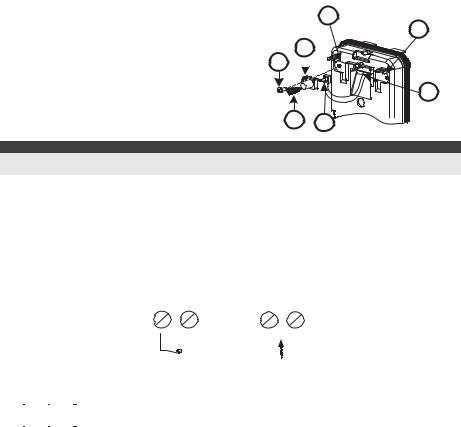
Modifica della posizione del tamper antirimozione
Di fabbrica il tamper antirimozione è fissato sul lato destro della base interna (vista posteriore). Se si desidera spostarlo nella parte sinistra (vista posteriore), procedere come segue (Figura 5):
1.Svitare la vite del tamper 1 per rimuoverlo dalla posizione 7.
2.Assicurarsi che la molla 2 del tamper resti posizionata sulla base 4 del tamper.
3.Assicurarsi che la staffa 3 del tamper resti tra 2 e 4.
4.Fissare la vite 1 del tamper in 3 sulla predisposizione 6.
Note:
Figura 5
Predisposizione |
|
|
tamper a sinistra |
Predisposizione |
|
6 |
||
tamper a destra |
7
3 1 
5
2 |
4 |
1.Verificare che si senta un "Click" quando la molla del tamper viene spinta verso il muro.
2.Per l’installazione su palo il tamper può essere spostato nella parte inferiore destra della base interna.
Cablaggio del tamper antirimozione
Se si desidera usare l’interruttore del tamper antirimozione (consigliato) rimuovere il cortocircuito dai morsetti del tamper antirimozione e collegare il filo dell’interruttore antirimozione ai morsetti dedicati al tamper antirimozione.
TAMPER ANTIRIMOZIONE
Utilizzo del tamper |
Tamper antirimozione |
antirimozione |
non utilizzato |
H1 |
H1 |
|
|
|
|
|
|
|
|
|
|
|
|
|
|
|
|
|
|
|
|
|
|
|
|
|
|
|
|
|
|
|
|
|
|
|
|
|
|
|
|
|
|
|
|
|
|
|
|
|
|
|
|
|
|
|
|
|
|
Cortocircuito |
|||||||
|
|
|
|
|
|
|
|
|
|
|
|
|
|
|
|
|
|
|
|
|
|
|
|
|
||||||||
|
Predisposizione Microinterruttori |
|
|
|
|
|
|
|
|
|||||||||||||||||||||||
|
|
ON |
|
|
|
|
|
|
|
|
|
|
|
|
|
|
|
|
|
|
|
|
|
MIC. 4: Tempo di supervisione |
||||||||
|
|
|
|
|
|
|
|
|
|
|
|
|
|
Default |
|
|
|
|
|
|
|
On: 15 minuti |
||||||||||
|
|
|
|
|
|
|
|
|
|
|
|
|
|
|
|
|
|
|
|
|
||||||||||||
|
|
|
|
|
|
|
|
|
|
|
|
|
|
|
|
|
|
|
|
|
|
|
|
Off: 65 minuti |
||||||||
|
|
|
|
|
|
|
|
|
|
|
|
|
|
|
|
|
|
|
|
|
|
|
|
|||||||||
|
|
1 |
2 3 4 5 6 |
|
|
|
|
|
|
|
|
|
|
|
|
|||||||||||||||||
MIC. 1: Predisposizione LED |
|
|
|
|
|
|
|
MIC. 5: Modalità Normale/Test |
||||||||||||||||||||||||
|
|
|
|
|
|
|
On: Test |
|||||||||||||||||||||||||
|
|
|
|
On: LED abilitati |
|
|
|
|
|
|
|
|||||||||||||||||||||
|
|
|
|
|
|
|
|
|
|
|
Off: Normale |
|||||||||||||||||||||
|
|
|
|
Off: LED disabilitati |
|
|
|
|
|
|
|
|||||||||||||||||||||
|
|
|
|
|
|
|
|
|
|
|
MIC. 6: Anti-Mask |
|||||||||||||||||||||
MIC. 2-3: Sensibilità di rilevazione PIR |
||||||||||||||||||||||||||||||||
On: abilitato |
||||||||||||||||||||||||||||||||
|
|
|
Sensibilità |
|
|
MIC. 2 |
|
|
MIC. 3 |
|
|
Off: Disabilitato |
||||||||||||||||||||
|
|
|
|
|
Bassa |
|
Off |
|
Off |
|
|
|
|
|
|
|
|
|
||||||||||||||
|
|
|
|
|
Media |
|
Off |
|
On |
|
|
|
|
|
|
|
|
|
||||||||||||||
|
Normale (default) |
|
On |
|
Off |
|
|
|
|
|
|
|
|
|
||||||||||||||||||
|
|
|
|
|
|
Alta |
|
On |
|
On |
|
|
|
|
|
|
|
|
|
|||||||||||||
Istruzioni per l’installazione |
19 |

Prova di movimento
Dopo 2 minuti dall’alimentazione del sensore, effettuare una prova di |
|
1.00M |
movimento all’interno dell’area protetta e verificare il buon funzionamento e la |
|
|
copertura del rivelatore. |
|
1.50M |
Per regolare la copertura del sensore muovere la scheda elettronica interna del |
|
2.20M |
sensore per la predisposizione appropriata in funzione dell’altezza di installazione |
|
2.70M |
|
desiderata (1.0m, 1.5m, 2.2m, 2.7m) come stampato nella parte inferiore sinistra |
PCB |
della scheda elettronica o, in alternativa, utilizzare lo snodo standard. |
|
Per ridurre l’area di copertura spostare in alto la scheda elettronica o, se |
|
utilizzato, orientare lo snodo verso il basso. |
|
Indicatori LED
|
LED |
Stato |
|
Descrizione |
|
|
ROSSO |
Acceso |
|
Indica ALLARME |
|
|
ROSSO E GIALLO |
ROSSO seguito dal GIALLO |
Indica ALLARME + ANTI-MASK |
|
|
|
Modi operativi: |
|
|
|
|
|
|
|
|
|
|
|
Modi operativi |
|
Descrizione |
|
|
|
Normale |
|
Il tempo di inibizione tra due trasmissioni è di 2.5 minuti. |
|
|
|
Test (prova di movimento) |
Il tempo di attesa tra 2 allarmi consecutivi è di 2.5 secondi. |
|
||
|
Trasmissione indirizzo (Write) |
Nella modalità di autoapprendimento l’unità trasmette un |
|
||
|
|
|
messaggio WRITE ogni volta che gli interruttori tamper |
|
|
|
|
|
(apertura e rimozione) vengono chiusi per almeno 3 secondi. |
|
|
|
Nota: |
|
|
|
|
All’alimentazione il rivelatore entra in modalità test per un periodo di 20 minuti senza la necessità di predisporre su ON l’apposito microinterruttore.
Autoapprendimento del trasmettitore
Il rivelatore deve essere identificato dall’unità ricevente tramite la memorizzazione del suo codice univoco. Questa operazione viene realizzata seguendo le fasi di seguito descritte:
1.Impostare l’unità ricevente in modalità WRITE per la ricezione dell’indirizzo del rilevatore (fare riferimento alle istruzioni fornite con l’unità ricevente).
2.Rimuovere il materiale isolante dalle batterie del rivelatore e inserirle negli appositi alloggi situati sulla scheda elettronica. Prestare attenzione alla polarità marcata con i simboli “+” e “–“ sulla scheda elettronica del rivelatore.
3.Trasmettere un messaggio di indirizzo (WRITE) premendo simultaneamente per almeno 3 secondi i due interruttori tamper dell’unità (tamper apertura e rimozione).
4.Verificare che il rivelatore sia stato correttamente identificato dal ricevitore (il ricevitore emette una segnalazione acustica e/o visualizza sul suo display il menù successivo).
AVVERTENZA
Modifiche o variazioni non approvate espressamente da RISCO Group possono fare decadere il diritto dell’utente all’utilizzo di questa apparecchiatura.
Trasmissioni simultanee da due differenti apparati possono causare interferenze e relativa perdita delle informazioni trasmesse.
La qualità di comunicazione di questa apparecchiatura può dipendere dall’ambiente in cui è installata. Apparecchiature elettriche situate nelle vicinanze possono creare interferenze al normale funzionamento dell’apparato.
Per i motivi citati il funzionamento di questa apparecchiatura deve essere testato ad ogni installazione poiché la qualità di comunicazione può variare al variare del sito di installazione.
NOTA:
Il microinterruttore 1 deve essere posto in ON per abilitare l’indicatore LED (tranne che per i primi 20 minuti di funzionamento dopo l’alimentazione del rivelatore).
20 |
Istruzioni per l’installazione |
